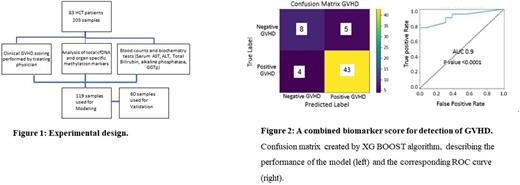Abstract

Accurate detection of graft versus host disease (GVHD) is a major challenge in the management of patients that undergo hematopoietic stem cell transplantation (HCT). Current diagnosis of chronic GVHD (cGVHD) in bone marrow transplant patients is based on inaccurate, operator-dependent clinical markers, and less often on biopsies. These methods are time consuming, costly, invasive and yield late-stage diagnoses that negatively affect morbidity and mortality. Here we demonstrate the use of circulating cell-free DNA (cfDNA) for detection of chronic GVHD and damage to specific organs. We established a cocktail of tissue-specific DNA methylation markers, and used it to determine the concentration of cfDNA molecules derived from the liver, skin, lungs, colon and specific immune cells in 203 samples from 82 HCT patients(Fig 1). Patients with active cGVHD show elevated concentration of cfDNA, as well as tissue-specific and immune cell driven methylation markers that agree with the 2014 National Institute of Health (NIH) clinical scores. Interestingly transplanted patients with no clinical symptoms show abnormally high levels of cfDNA and tissue-specific markers, suggesting hidden tissue turnover even in the absence of evident pathology. We used machine learning to create a model, which can aid predicting the likelihood that a patient has cGVHD. We compared XG boost and random forest classifiers on our data set. Algorithms were tested on data that included pre-selected specific measures (cfDNA of skin, lung, liver, GI, neutrophils, monocyte, eosinophil, T lymphocytes, CD8+ cells, Treg cells and B lymphocytes, as well as white blood cell (WBC) counts, BIL, AST, ALT and ALP liver enzyme levels). The data was randomly divided to a training set consisting of 67% of the samples and a testing set consisting of the remaining 33%. The model was constructed based on the training set alone that was later verified on the testing set. As the XG boost model had both higher accuracy as well as more robust results by cross-validation, we applied XG boost for further analyses. A total of 179 samples were divided between the training and test set. One hundred nineteen samples were randomly chosen for training the machine learning classifier, while 60 samples were used solely for testing the model. Each sample was intended either for the training or test sets. The integrative model was able to correctly identify GVHD with a sensitivity of 91.49% and precision of 89%% (AUC of 0.9, Fig 2). Our study shows that tissue-specific DNA methylation patterns can serve as plasma biomarkers for detection of tissue damage in cGVHD. To our knowledge, this is the first report of potential tissue-specific cfDNA utility in the context of chronic GVHD. Larger cohorts will be needed to assess the prognostic potential of methylation-based biomarkers. Tissue-specific cfDNA markers can open a window into uncovering underlying tissue dynamics in patients who underwent allogeneic stem cell transplantation.
Disclosures
Avni:MSD: Membership on an entity's Board of Directors or advisory committees. Zuckerman:Orgenesis: Honoraria, Membership on an entity's Board of Directors or advisory committees, Speakers Bureau; Gilead: Honoraria, Membership on an entity's Board of Directors or advisory committees, Speakers Bureau; BioSight Ltd: Honoraria, Membership on an entity's Board of Directors or advisory committees, Speakers Bureau; Cellect Biotechnology: Honoraria, Speakers Bureau; Janssen: Honoraria, Speakers Bureau; Novartis: Honoraria, Speakers Bureau.
Author notes
 This icon denotes a clinically relevant abstract
This icon denotes a clinically relevant abstract
Asterisk with author names denotes non-ASH members.


This feature is available to Subscribers Only
Sign In or Create an Account Close Modal